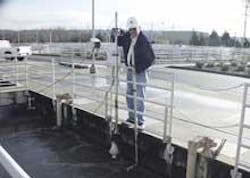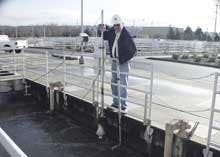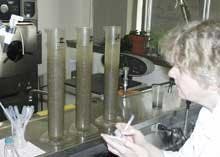Automated SVI Analyzer Helps Optimize Treatment System
Julie A. Schlegel
It's likely that operators at most secondary wastewater treatment plants both curse and cheer the traditional 30-minute sludge settling test. This laboratory measurement, along with other tests, helps them monitor settled sludge volume and often provides the first alert to the need for treatment adjustment to preserve proper biological processes in the aeration basin.
Yet it is a technique-sensitive test that's time consuming. The tester monitors the sludge sample blanket as it settles in a bench-top cylinder that simulates the clarifier. Observations at intervals over the 30-minute test period determine the sludge volume (SV) in mL/L.
Variations in re-mixing, temperature, settling column size, dilution, and time between the manual sampling and start of the test all affect results significantly. Then, the tester manually identifies the suspended solids concentration in mg/L by a separate test and calculates the sludge volume index (SVI), which tells the operator the density (mL/g) of the sludge.
Even when completed consistently and efficiently, the settling test can be misleading. In a good quality sludge, most of the settling often occurs in the first few minutes. By the end of the 30-minute test, however, a less-compacting, lower quality sludge could exhibit the same settling level as the good quality sludge. In such a case, if the two test samples contain the same concentration of suspended solids, even the calculated SVI will appear the same while the sludges exhibit different settling characteristics.
Yet, with all the drawbacks of the bench-scale settling test, operators still trust it to make sludge management decisions, because nothing better has been available. Until recently.
Initial Settling Velocity and Rated Capacity
That's why the operators at the 115 mgd King County Wastewater Treatment Plant at Renton, WA, are adding yet another settling test acronym to their jobsite jargon: ISV, which stands for Initial Settling Velocity (not to be confused with Sludge Volume Index, SVI). Sludge ISV, expressed as feet per minute, reflects the first few minutes of settling and is the steepest part of the settling curve. Using the ISV value as described in the British journal Water Research as early as 20 years ago allows an operator to calculate a clarifier's rated capacity, or the flow of mixed liquor (exclusive of return sludge flow) that can be fed to the clarifier to maintain treatability.
Jim Pitts, Senior Process Analyst at the Renton plant, wants to be able to use ISV and rated capacity values to optimize the treatment process there. Located 10 miles south of Seattle, the Renton facility receives its fair share of rain.
"I'm interested in what happens in between the beginning and the end of the settling test so we can better understand the capacity of flow we can handle with heavy or frequent rain," Pitts said. "Simply knowing the accurate sludge ISV and associated rated capacity could give us an estimate of maximum flow treatable. Those characters would tell us how much wet weather flow the clarifier can tolerate without suffering deterioration of effluent quality."
Determining ISV requires observation of sludge blanket level in the traditional settling test at 30-second intervals for the first five minutes of the test. Unfortunately, when the rain starts is when the Renton facility crew can least afford to spend time taking those readings and calculate ISV and rated capacity.
"When it rains, our operators are taxed to the max," he said.
For the Renton operators, or any operators, using ISV and rated capacity has not been a practical, real-time tool because of the tedious settling test observations, curve plotting, and calculations required.
Automated Settling Data
Pitts thinks he's found his solution, with the installation of an automated sludge volume and SVI analyzer. This analyzer, the OptiQuant SVI™ Sludge Volume and SVI Analyzer from Hach Co., is the first instrument available that automates the traditional settling test. It uses a sampling vessel positioned directly in the aeration basin, or at the Renton plant, in a mixed liquor channel representing all four aeration basins, and continuously measures sludge settling in situ. Using readings from an additional OptiQuant TS-line suspended solids probe, the analyzer automatically determines the sludge volume index every 30 minutes; all determinations are completed according to standard methodology. Comparing analyzer readings with manual tests has convinced Pitts the instrument is providing accurate, repeatable data.
Doing More with Less
There are two reasons why Pitts is excited about using the Hach analyzer. First, it allows more efficient operation. Using the analyzer, Renton operators see about 40 SVI readings a day, compared to the four tests per day run on each basin and the return activated sludge. And they save at least two hours a day in time spent collecting sludge samples, transporting them to the laboratory, diluting and setting up tests, and recording data.
Operators now know the settling rate at any time of day, during any weather, no matter who's on vacation, and regardless of what other issues arise requiring operator attention. Automatic output to the facility's distributive control system will provide operators reliable data and early warning of changing sludge characteristics signaling bulking or overloading. They also can use the real-time data to monitor, in an efficient manner, sludge response to treatment adjustments. And with a six-minute auto-clean cycle of the sampling vessel after each determination, the analyzer itself has not required much operator attention.
"Since we installed it in November 2002 the sampling vessel has not needed cleaning," Pitts said.
The second benefit, according to Pitts, is that he can reap real-time sludge settling measurements, continuously displayed by the analyzer with settling time, to identify the ISV and rated capacity factor of the facility. Knowing the relationship between the plant's flow and rated capacity at any time allows operators the ability to adjust flow gates or activated sludge return for optimum clarifier performance.
Renton operators have demonstrated a great track record in minimizing suspended solids levels in the plant effluent, which continuously measures from 12 to 15 mg/L total suspended solids (TSS), well below the plant's permitted 45 mg/L weekly average TSS and 30 mg/L monthly average TSS. In fact, the facility will earn the Platinum Award from the Association of Metropolitan Sewerage Agencies (AMSA) this year for consistently meeting permit parameters for five years. Pitts, a progressive process analyzer, won't sit on those laurels, though.
"Certainly, we must attribute our recognized excellent operation to a well-trained staff and a well-designed facility. Yet, investigating better ways to operate contributes to this level of performance, too," he added. "We all need to look for ways to do more with less."
Of course, the Renton operators know that monitoring and management of dissolved oxygen (DO), organic loading, and other factors also affect treatment efficiency and sludge quality. They rely on analyzers for automated monitoring of pH, conductivity, turbidity, DO, and chlorine residual. With the addition of the Hach OptiQuant SVI Sludge Volume and SVI Analyzer and the real-time data it provides, operators can monitor SV, SVI, ISV, and rated capacity quickly.
According to Pitts, "We want to make process decisions quickly, based on reliable data. This analyzer gives us the capability to do that."
About the Author: Julie A. Schlegel has worked in the water quality analysis and animal health industries for nearly 30 years, providing communication support in product research and marketing. Currently she is a freelance technical writer and editor.

